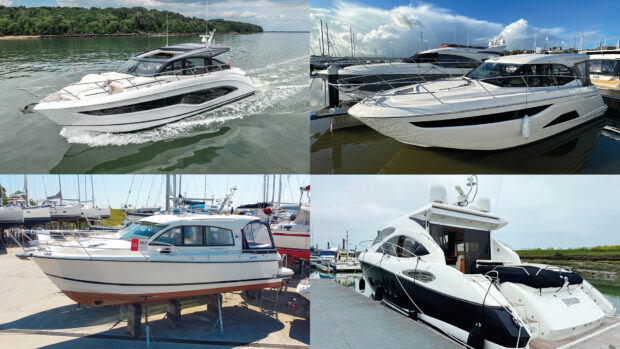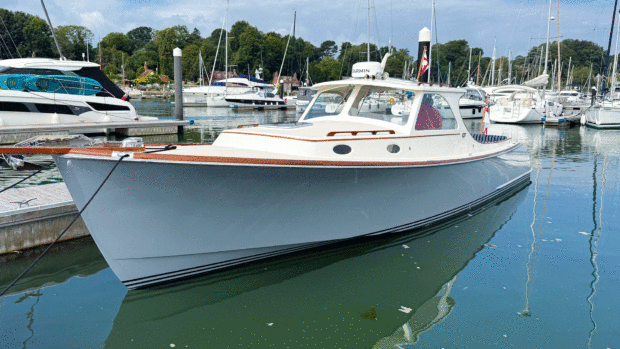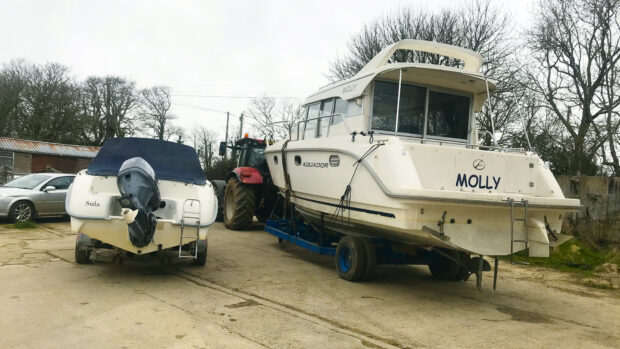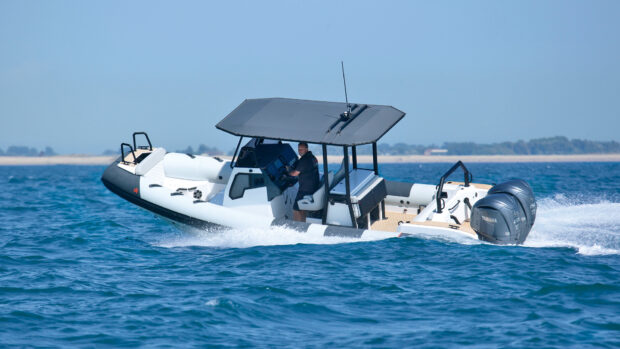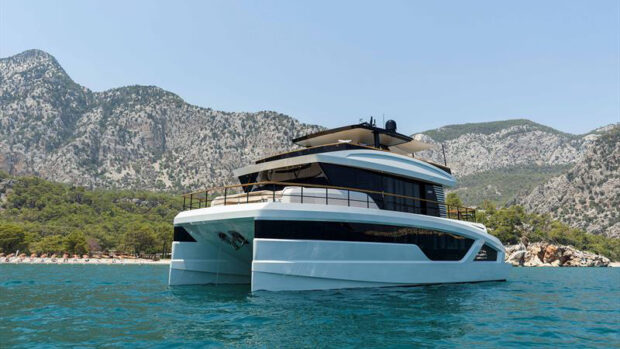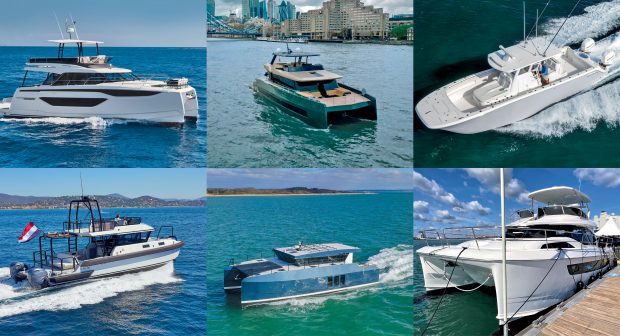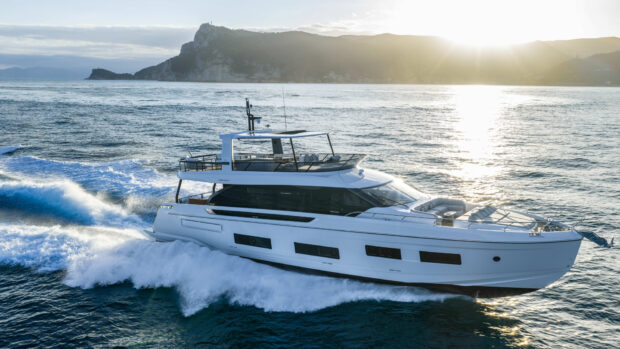We pick 4 of the best classic motor yachts on the market right now. From a multi-million £ wooden cruiser to an early example for Princess Yachts
Finding a vintage boat is easy, pick anything over 25 years old and voila, as they say in Germany. But picking a classic, well that is a little more nuanced because to truly be a classic, there has to be something a little more to it than just being old.
It has to have had a storied history, or be an icon of its genre, or perhaps be a perfect example of what the brand stood for in that moment in time. And maybe it doesn’t even need to be old at all, maybe some boats, like some cars and some watches, are simply destined to be classics from inception.
And to that end, we have four examples of each of those categories here, from the rich past of Lady Hertha to the signpost of company direction in the early eighties that the Princess 33 clearly was. All are bona fide classic boats.
Princess 33 MK2
Built: 1984
Price: £29,950
Can we call the Princess 33 MK2 a classic? I believe so because this is actually quite an iconic boat in the history of Princess Yachts.
Marine Projects, as it was originally known, started life in 1965 with the Project 31, which morphed into the first ever Princess in 1969, the Princess 32. Its first flybridge was the 37 in 1973 and the MK1 Princess 33 followed in 1974.
This was a deck saloon boat, with the option of a small flybridge. The 33 Mk2 that followed it in 1981 differed by being predominantly a flybridge boat (although a non flybridge version was available) and it set the tone for all Princess boats through the 1980s.
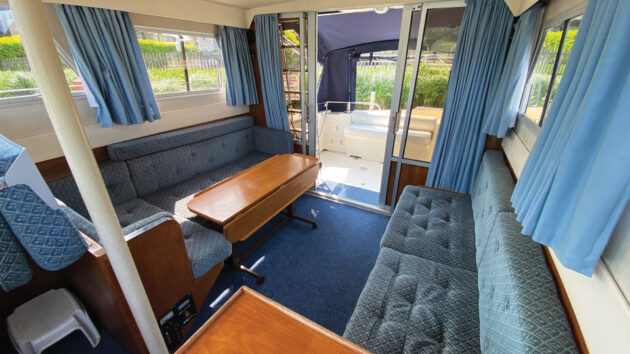
The main deck saloon is simple but spacious and could easily be updated at minimal cost
Interior
It also set the pattern for the builder’s interiors, with most of its models from this era following a similar saloon on the main deck, galley and cabins on the lower deck layout.
In fact there were two lower deck layout options. Whilst the vee berths in the forward cabin and L-shaped galley to port, aft of the heads, was fixed, buyers could opt for a dinette to starboard or the second cabin of the boat featured here with its bunk beds.
Exterior
As mentioned, this boat was built as a flybridge and is so well proportioned that the occasional non-flybridge version looks slightly odd. Accessed by a ladder, the flybridge is a little larger than the token effort of the MK1, and has a three-person seat at the helm with a radar mast behind it.
Performance
Marine Projects offered a wide variety of Volvo Penta engines, from petrol sterndrives through to diesel sterndrives and diesel shaft drives, which this boat has. Arguably the optimum choice, the twin 165hp TAMD 40 engines should give speeds of towards 20 knots.
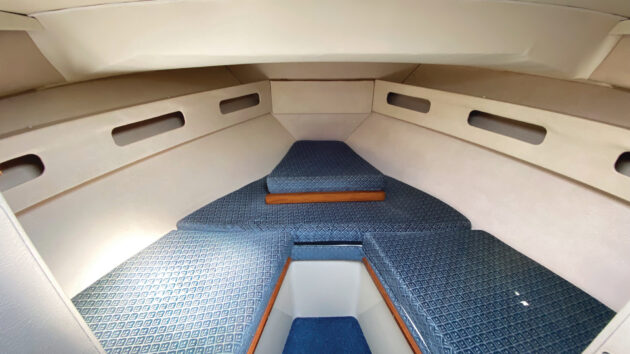
The main forward cabin is supplemented by a lower dinette or a second cabin
Seakeeping
The best thing about shaft drive, beyond the sheer simplicity compared to sterndrives, is the fact that it pushes the weight of the engines forward, helping to keep the bow down. John Bennett designed these earlier Princesses and they are solid performers.
Princess 33 MK2 specifications
Length: 33ft 0in (10m)
Beam: 11ft 3in (3.4m)
Draft: 3ft 0in (0.9m)
Displacement: 5 tonnes
Fuel capacity: 590 litres
Engines: Twin Volvo Penta TAMD 40 165hp diesel engines
For Sale: Karl Farrant Marine Sales
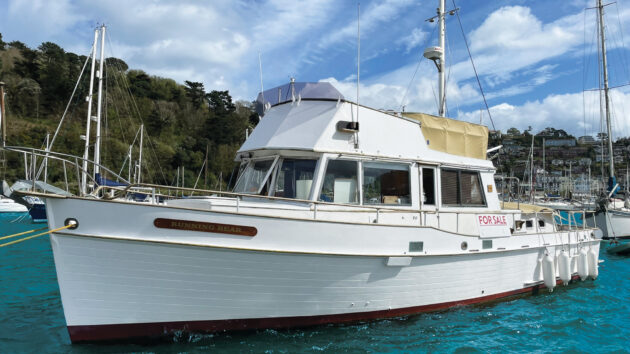
Grand Banks 42
Built: 1970
Price: £39,500
The Grand Banks 42 could be credited for setting the template for every Grand Banks up to recent times, and indeed arguably the template for the entire trawler yacht genre, with many other companies such as Island Gypsy and C-Kip producing boats modelled along similar lines.
Even modern ‘trawler yachts’ such as the Beneteau Swift Trawler range owe at least a nod to Grand Banks for the visuals, if not their more modern interiors. Although not the first Grand Banks (that was the 36 Classic launched in 1964), the 42 was certainly one of the most successful and long lived – it was launched in 1975 and ran for 30 years!
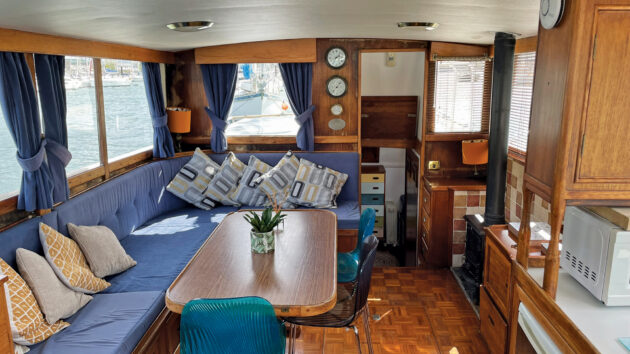
Traditional wood heavy interior is in keeping with its classic trawler yacht exterior lines
Interior
Featuring an aft cabin layout, one of the great things about the classic trawler yacht is the way that the accommodation spreads itself across almost the full length of the vessel, and it’s clear to see why these are so popular for extended cruising or even living aboard.
The aft cabin is designated the owner’s cabin, with its double bed and ensuite. A couple of steps forward take you up to the saloon which also houses the galley and the lower helm, a set up which is very sociable when underway. Drop down to the lower deck to find vee berths in the forward cabin and another heads.
Exterior
An early example, this is a proper wooden boat (later Grand Banks were GRP). The hull is carvel planking in mahogany, bronze fastened to wooden frames while the superstructure is painted plywood. The side decks on these classic layouts encircle the entire boat, with the aft deck raised above the aft cabin, in turn offering access to a large flybridge via another couple of steps. A mast and boom can be used to lift a tender onto the raised coachroof.
Performance
Twin Ford Lehman 6-cylinder 120hp naturally aspirated diesel engines offer stately progress, cruising at a gentle 10-12 knots which is in keeping with this sort of boat.
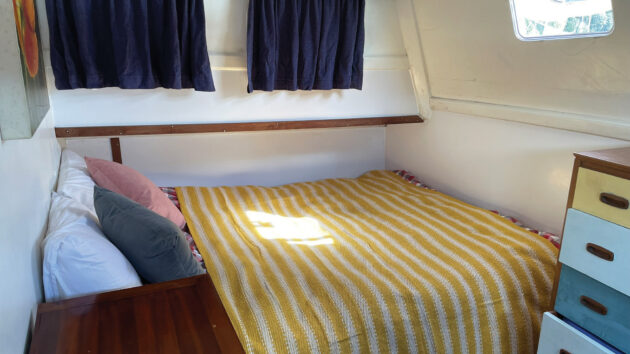
With a cabin and heads at either end this makes for a comfortable cruising boat
Seakeeping
A heavy full displacement hull with a deep forefoot is designed with long distance cruising in mind. There is a pleasingly unstoppable nature to the way they travel.
Grand Banks 42 specifications
Length: 42ft 7in (13m)
Beam: 13ft 7in (4.1m)
Draft: 4ft 2in (1.3m)
Displacement: 20 tonnes
Fuel capacity: 1,200 litres
Engines: Ford Lehman 120hp diesel
For Sale: Wooden Ships
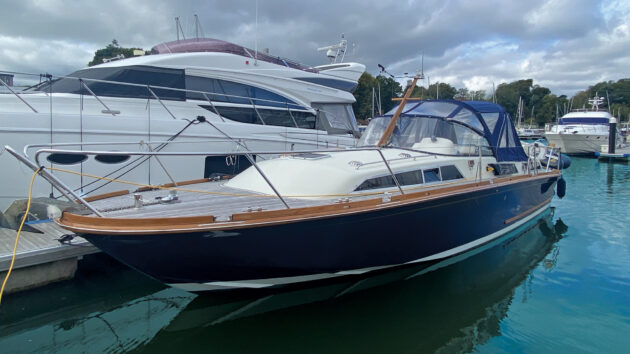
Swordsman 40
Built: 2004
Price: £169,950
Does a classic have to be vintage to qualify? I don’t think so, and this 2004 Swordsman 40 backs me up. It’s based along the lines of the ultimate classics, the Fairey range of wooden cruisers from the 1960s that included the Huntsman, Spearfish and, of course, the original Swordsman, which started off life as a 33-footer but was later extended to 38 and 42ft versions.
Giving that name authenticity is a GRP hull designed by Alan Burnard, who penned those beautiful Fairey boats way back when. It was originally intended for a fibreglass offshore patrol boat called the Fairey Dagger and was based on a modified version of the original Fairey Swordsman hull.
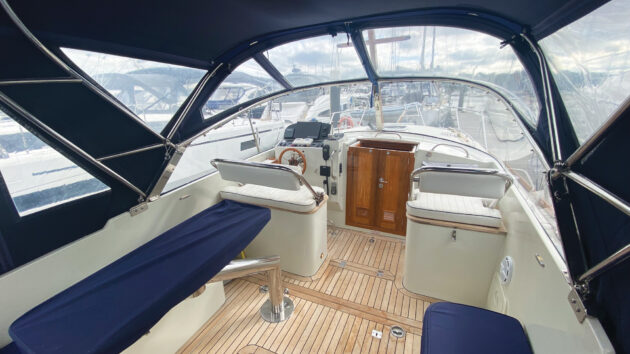
Wide sides make for a rather slender but well protected cockpit and helm
Interior
Like many of those original Fairey Swordsman boats, this is an aft cabin layout. Accessed at the aft end of the cockpit, it’s a completely private space cut off from the rest of the accommodation and sports a transverse double bed and an ensuite. If you head forward from the cockpit and drop to the lower deck you’ll find the galley and dinette plus another heads and a forward cabin with vee berths. Lots of teak cements that classic vibe.
Exterior
From the flared bow to the Flag Blue topsides and the ring of wide teak decks fitted with a varnished teak capping rail, this has the look and feel of a bona fide classic. Squeezed a little by those wide decks and cabins, the cockpit features twin helm seats forward and a small pair of L-shaped settees at the aft end.
Performance
Rolls-Royce KaMeWa waterjets keep the draft low and the manoeuvrability high. They’re linked to a pair of Cummins 480hp diesel engines beneath the cockpit floor and controlled by four lever race-style Morse engine controls. Top speed is a thoroughly modern 40 knots!
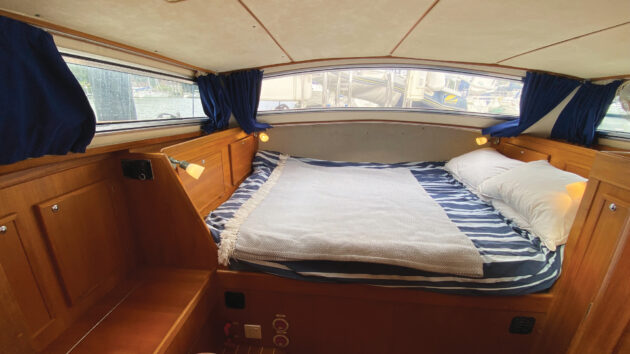
Cosy aft cabin is awash with handcrafted teak for that authentic classic vibe
Seakeeping
That Fairey Dagger hull designed by Alan Burnard tells you all that you need to know, you’re unlikely to find better seakeeping from a 40ft sportscruiser. Interestingly, water jets have no forward and reverse gears, reverse thrust is created by dropping ‘buckets’ that redirect thrust forward, giving the unusual and spectacular ability to go from full ahead to full astern without throttling down.
Swordsman 40 specifications
Length: 40ft 0in (12.2m)
Beam: 11ft 5in (3.5m)
Draft: 2ft 4in (0.7m)
Displacement: 9 tonnes
Fuel capacity: 1,136 litres
Engines: Twin Cummins 480hp diesel engines
For Sale: Berthon
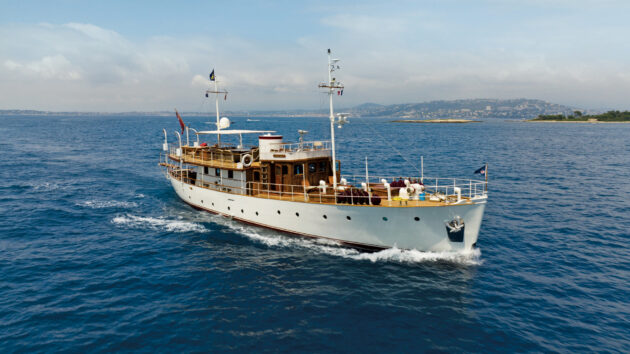
Yarrow & Co
Built: 1935/2024
Price: €3,950,000
If you want history, Lady Hertha has it in spades. Originally called Destiny she was built in 1935 by Yarrow & Co on the Clyde River in Scotland for Lt Eric Gordon, a veteran of World War One.
Gordon enlisted with the 10th Battalion Highland Light Infantry but was so seriously wounded that he was officially declared “not fit for anything but general service at home.” He begged to differ, joined the Royal Flying Corps (the only service not requiring a medical) and was flying a Sopwith Camel six weeks later! And the military history doesn’t end there because in 1943 Destiny was requisitioned by the Royal Navy and wound up in Bootle Docks as a fire boat, complete with four 700gpm pumps and eight deliveries. She re-entered private ownership in 1955.
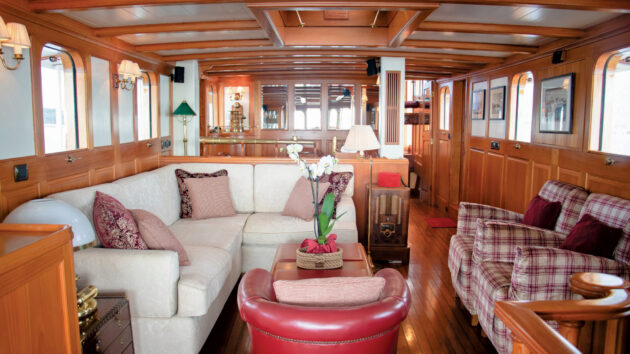
Tastefully remodelled interior looks beautiful but is far better suited to modern life
Interior
Now named Lady Hertha, the joy of this boat is that, despite the absolutely classic look and feel, she has undergone extensive refits in the hands firstly of Amico & Co in Genoa and within the careful stewardship of her current owner, who bought her 13 years ago as his first boat!
The layout has altered, with the three cabins aft now converted into one guest cabin and one owner’s cabin far larger than the original. The formal dining room on the lower deck forward is now a third cabin, inside dining having moved to the front section of the saloon. Beyond that, everything from air conditioning and wiring to modern push-button plumbing has been incorporated, all of it carefully concealed to retain the classic feel.
Exterior
It’s a similar story on the outside, with subtle and light touch modifications in no way impinging on the fabulously original styling. The bridge, for example, is a feast of period-perfect details like the huge wheel and massive brass compass, but sympathetically integrated are Raymarine electronics and a modern autopilot system.
Performance
Re-engined in 1955, the original motors made way for a pair of Gardiner 150hp eight-cylinder diesels offering a stately 9-knot cruise at just 750rpm.
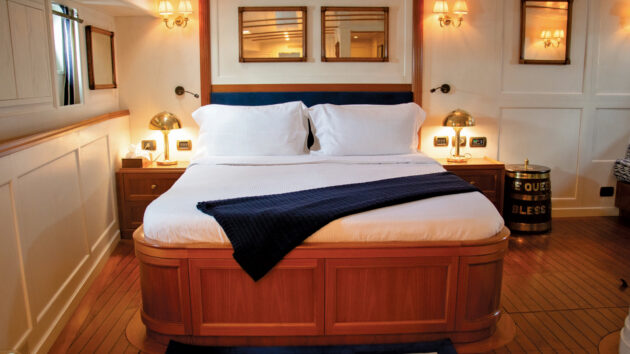
The spacious master cabin is a luxurious haven for any potential new owner
Seakeeping
Designed by G L Watson, she’s 86ft of steel hull, solid teak decking and teak superstructure. Seakeeping, therefore, is as stately as everything else about her.
Yarrow & Co specifications
Length: 86ft 7in (26.4m)
Beam: 17ft 5in (5.3m)
Draft: 9ft 10in (3.0m)
Displacement: 60 tonnes
Fuel capacity: 10,000 litres
Engines: Gardiner 150hp diesel engines
For Sale: Fraser Yachts; www.fraseryachts.com
 If you enjoyed this….
If you enjoyed this….
Motor Boat & Yachting is the world’s leading magazine for Motoryacht enthusiasts. Every month we have inspirational adventures and practical features to help you realise your sailing dreams, as well as tests and news of all the latest motorboats.
Plus you’ll get our quarterly Custom Yachting supplement where we share the last on offer in the superyacht world and at the luxury end of the market.
Build your knowledge with a subscription delivered to your door. See our latest offers and save at least 30% off the cover price.
Note: We may earn a commission when you buy through links on our site, at no extra cost to you. This doesn’t affect our editorial independence.
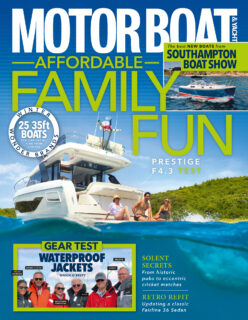

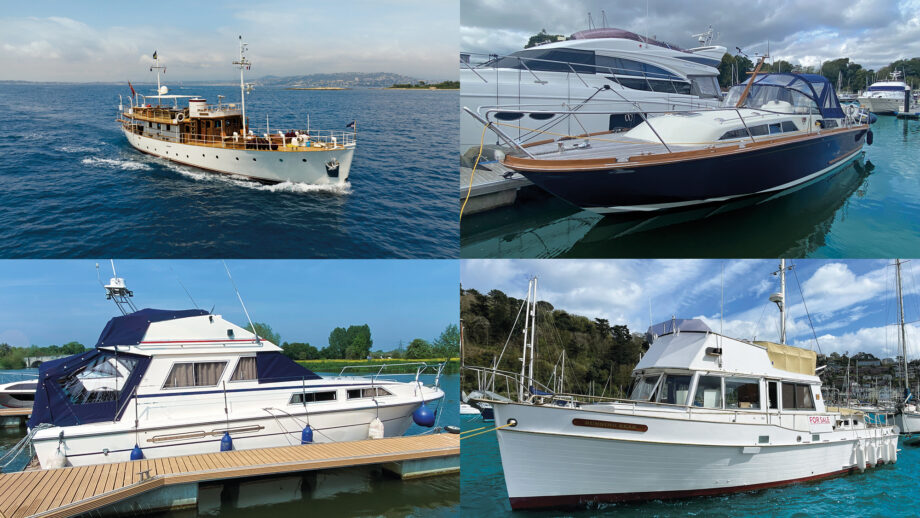
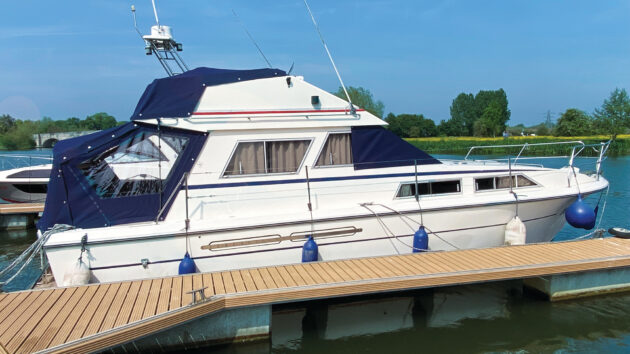
 If you enjoyed this….
If you enjoyed this….